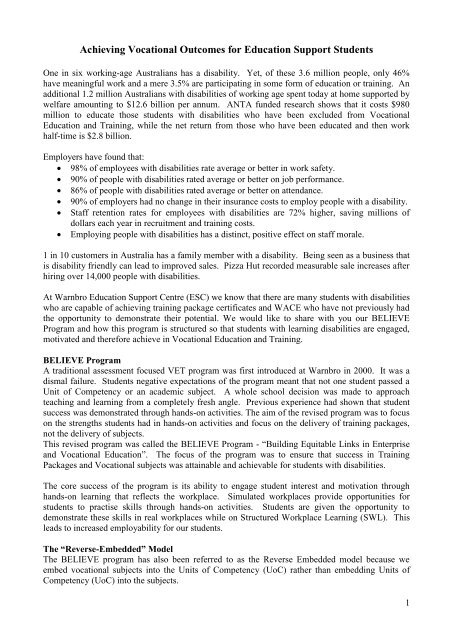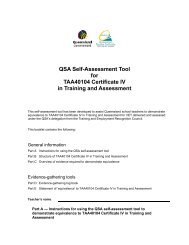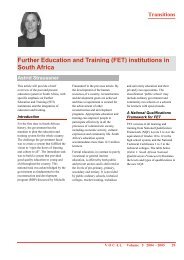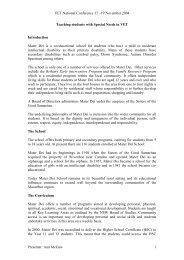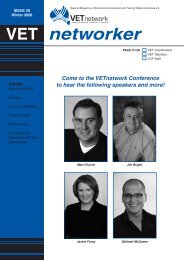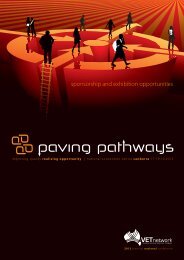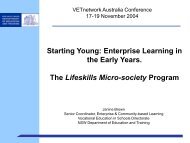Achieving Vocational Outcomes for Education Support Students (text)
Achieving Vocational Outcomes for Education Support Students (text)
Achieving Vocational Outcomes for Education Support Students (text)
Create successful ePaper yourself
Turn your PDF publications into a flip-book with our unique Google optimized e-Paper software.
<strong>Achieving</strong> <strong>Vocational</strong> <strong>Outcomes</strong> <strong>for</strong> <strong>Education</strong> <strong>Support</strong> <strong>Students</strong>One in six working-age Australians has a disability. Yet, of these 3.6 million people, only 46%have meaningful work and a mere 3.5% are participating in some <strong>for</strong>m of education or training. Anadditional 1.2 million Australians with disabilities of working age spent today at home supported bywelfare amounting to $12.6 billion per annum. ANTA funded research shows that it costs $980million to educate those students with disabilities who have been excluded from <strong>Vocational</strong><strong>Education</strong> and Training, while the net return from those who have been educated and then workhalf-time is $2.8 billion.Employers have found that: 98% of employees with disabilities rate average or better in work safety. 90% of people with disabilities rated average or better on job per<strong>for</strong>mance. 86% of people with disabilities rated average or better on attendance. 90% of employers had no change in their insurance costs to employ people with a disability. Staff retention rates <strong>for</strong> employees with disabilities are 72% higher, saving millions ofdollars each year in recruitment and training costs. Employing people with disabilities has a distinct, positive effect on staff morale.1 in 10 customers in Australia has a family member with a disability. Being seen as a business thatis disability friendly can lead to improved sales. Pizza Hut recorded measurable sale increases afterhiring over 14,000 people with disabilities.At Warnbro <strong>Education</strong> <strong>Support</strong> Centre (ESC) we know that there are many students with disabilitieswho are capable of achieving training package certificates and WACE who have not previously hadthe opportunity to demonstrate their potential. We would like to share with you our BELIEVEProgram and how this program is structured so that students with learning disabilities are engaged,motivated and there<strong>for</strong>e achieve in <strong>Vocational</strong> <strong>Education</strong> and Training.BELIEVE ProgramA traditional assessment focused VET program was first introduced at Warnbro in 2000. It was adismal failure. <strong>Students</strong> negative expectations of the program meant that not one student passed aUnit of Competency or an academic subject. A whole school decision was made to approachteaching and learning from a completely fresh angle. Previous experience had shown that studentsuccess was demonstrated through hands-on activities. The aim of the revised program was to focuson the strengths students had in hands-on activities and focus on the delivery of training packages,not the delivery of subjects.This revised program was called the BELIEVE Program - “Building Equitable Links in Enterpriseand <strong>Vocational</strong> <strong>Education</strong>”. The focus of the program was to ensure that success in TrainingPackages and <strong>Vocational</strong> subjects was attainable and achievable <strong>for</strong> students with disabilities.The core success of the program is its ability to engage student interest and motivation throughhands-on learning that reflects the workplace. Simulated workplaces provide opportunities <strong>for</strong>students to practise skills through hands-on activities. <strong>Students</strong> are given the opportunity todemonstrate these skills in real workplaces while on Structured Workplace Learning (SWL). Thisleads to increased employability <strong>for</strong> our students.The “Reverse-Embedded” ModelThe BELIEVE program has also been referred to as the Reverse Embedded model because weembed vocational subjects into the Units of Competency (UoC) rather than embedding Units ofCompetency (UoC) into the subjects.1
We cluster units of competency together to simulate real workplace tasks. We have found that bydoing this we have generated purposeful reasons <strong>for</strong> completing English, Maths and Career &Industry Awareness tasks. The simulated workplace tasks provide a link <strong>for</strong> students betweenschool-based activities and the workplace. School based practice firms, business enterprise andenterprise projects greatly enhance students’ ability to directly link off-the-job learning to on-thejobsuccess.BELIEVE PathwaysOver the years the BELIEVE Program has expanded in order to cater <strong>for</strong> the growing needs of ourstudents. At present students enter year 10 having done some career studies in years 8 and 9.In year 10 the majority of students take the Business Services pathway. They complete BusinessServices Certificate I, and participate in Structured Workplace Learning (SWL). Their academicprogram prepares them <strong>for</strong> the <strong>Vocational</strong> Subjects they will take in years 11 and 12.The Retail and Construction pathways are generally offered to students in years 11 and 12, butstudents may enter in year 10 if this is deemed the most appropriate pathway <strong>for</strong> the individualstudent. <strong>Students</strong> following these pathways participate in Retail Certificate I & II or GeneralConstruction Certificate I & II. These students all participate in SWL, <strong>Vocational</strong> English,<strong>Vocational</strong> Maths, Career and Industry Awareness (CIA), Independent Living, and mainstreamsubjects to suit their industry area.The LINC – or Learning in the Community Pathway is open <strong>for</strong> students from years 10 to 13. Thispathway is aimed at students who have already completed one of the other pathways, who may notbe suited to one of the other pathways, or <strong>for</strong> those students who require more of a Life Skills focus.<strong>Students</strong> in this pathway complete Kitchen Operations Certificate I and Automotive Cert I at TAFE.They participate in SWL one day per week and complete activities related to life skills andcommunity access.Planning ProcessHaving provided a brief background to Warnbro <strong>Education</strong> <strong>Support</strong> Centre and the BELIVEprogram, we would like to explain in more detail the structure of the pathways so that students withlearning disabilities are able to attain success in Training Packages and <strong>Vocational</strong> Subjects.For each industry area there are a number of UoCs that are delivered at school. The industry areasprovide the con<strong>text</strong> <strong>for</strong> the enterprise and the simulated real work tasks that are generated from theenterprise provide a meaningful purpose <strong>for</strong> the delivery of the vocational subjects.Retail PathwayIn Retail, 2004, the students have designed a business that they have called “Recino – The RetailCappuccino Shop”. In this business, the students make and sell coffees and lunches to staff at theschool, one day per week. There are five UoC that the students are able to demonstrate through thisbusiness. The largest unit is the communication unit. <strong>Students</strong> get to demonstrate competence inthis unit through their presentation, using the telephone, through their communication withcustomers, working in teams, following instructions, using numbers in the workplace andinterpreting retail documents. Through the enterprise, students are also able to demonstrate theirhousekeeping skills, their ability to work safely, their ability to operate retail equipment, and theirskills to work effectively. The enterprise provides the opportunity <strong>for</strong> the students to completeEnglish activities such as completing order <strong>for</strong>ms, interpreting retail documents, and negotiating.The students are completing maths activities when they are calculating costs of items, estimatingmeasurements and managing time. The skills the students develop while participating in theenterprise are skills they can include in their portfolio, which is a Career and Industry Awareness2
Task. The students are also learning important work management tasks such as acting on feedback,following lines of communication and prioritising tasks. These skills will help them on SWL.Construction PathwayThe construction students are working with the School Gardeners to maintain different areas of theWarnbro School <strong>for</strong> their enterprise project. This includes demolishing existing garden areas anddesigning and maintaining new garden beds, building limestone walls to control traffic flow ofstudents, providing seating <strong>for</strong> students and providing protection to existing garden areas. Thisenterprise provides a vehicle <strong>for</strong> the delivery of four of the Construction Units of Competency. Thestudents have to read plans in the design and construction of the garden beds, they get todemonstrate measurement skills, follow occupational health and safety regulations andcommunicate with others. English skills are demonstrated when they present their proposals to theSchool administrative members, the students participate in regular meetings to discuss the progressof their work and when they give and follow instructions in order to complete their work. Mathsskills are demonstrated when the students measure and mark out their working area and calculatethe area and perimeter of the garden areas. Through these projects, the students re learningimportant work related skills such as working in a team, managing their time productively andcommunicating effectively with others.<strong>Vocational</strong> SubjectsThe <strong>Vocational</strong> subjects delivered at Warnbro ESC are <strong>Vocational</strong> English, <strong>Vocational</strong> Maths andCIA. Each of these subjects has a set of Common Assessment Tasks that the students mustcomplete. Per<strong>for</strong>mance on each assessment task is assessed according to a set of outcomes, specific<strong>for</strong> each subject. Achievement of each outcome is rated according to a scale, Satisfactory, High orVery High. Because these subjects are vocational based, the tasks students are required to completecan be adapted to suit the con<strong>text</strong> of the enterprise and there<strong>for</strong>e meet the needs of students withdisabilities.The Enterprise Learning CycleThe Enterprise Learning Cycle is used to structure the enterprise, business or project. In eachphase, integrated assessment tasks are designed to meet Unit of Competency requirements as wellas CAF requirements.The Enterprise Learning Cycle starts with students sharing ideas on a problem, issue or concept,through group discussions and making a decision on their project/business focus. This is theConcept Development phase of the cycle. The emphasis in this phase is on identifying directionsand <strong>for</strong>mulating outcomes in relation to a product, service or solution. An example of anassessment task designed to suit this phase is one titled, “OSH Audit”. This task was designedbecause in both the Retail and Construction pathways, there is a whole UoC related to safety. Inthis assessment task students are required to assess the different safety aspects of theirbusiness/project. Firstly, they collect and research different safety audits to find out what they areall about. They then generate their own safety checklist, which is an English task; designing <strong>for</strong>ms.The students then carry out their safety audit by completing their checklist. This is another Englishtask, requiring students to complete <strong>for</strong>ms. <strong>Students</strong> were then required to collate the results fromtheir checklist and write a report on their findings. This part of the task met the requirements <strong>for</strong> anEnglish task of report writing as well as a CIA task of writing an OSH report.The next phase is the Production and testing phase. This is the doing part of the cycle. This iswhere the students start to create a product or per<strong>for</strong>m a service in order to run theirbusiness/project. Along with this is the testing, collecting and analysing of feedback on a product,service or solution. One of the ongoing activities in this phase is <strong>for</strong> students to order theequipment and materials needed to run their business. There<strong>for</strong>e, an integrated assessment tasks3
called “Ordering Materials” was designed. This task assessed Retail and Construction UoCs as wellas CAF subject requirements. The Retail UoCs that are assessed through this task include;communicating in the workplace, establishing contact with customers/clients, followinginstructions, using numbers when calculating quantities and costs, and interpreting retail documentswhen finding out where and how to order materials. The Construction UoCs that are assessedinclude; measuring and calculating when working out quantities and costs of materials required, andeffective workplace communication through the accurate completion of order <strong>for</strong>ms and faxes. Thefirst part of this assessment involved a group activity to determine the materials and quantitiesneeded to start/continue the running of their business which is part of an English task; participatingin meetings. <strong>Students</strong> had to find quotes and compare prices, which was a Maths task of readingand interpreting tables. The students then had to determine and justify the best/cheapest way o<strong>for</strong>dering the materials and then calculate the total cost of the equipment needed. This again met aMaths task of measuring as well as costing. Lastly, students were required to complete theappropriate order <strong>for</strong>m with all the correct details, attach a covering fax letter and send it to thesupplier. This part of the task met English requirements of designing and completing <strong>for</strong>ms.In the Marketing phase of the cycle the product is advertised and promoted. As promotion is part ofstandard business practice, an integrated assessment titled, “Advertising” was designed. Whendesigning an advertisement, students were also completing activities that contribute to UoC and<strong>Vocational</strong> outcomes. For Retail, an advertisement is a type of retail document which contributes tothe communication UoC and being able to interpret retail documents. For Construction, anadvertisement demonstrates the students’ ability to receive and convey in<strong>for</strong>mation whichcontributes to the workplace communication UoC. An advertisement also is type of <strong>for</strong>mcontributing to an English task.The Reflection phase of the cycle involves determining the success of the activity and determiningthe direction of future activities. As this is a cycle this phase also in<strong>for</strong>ms the beginning and end ofthe enterprise learning cycle. As many businesses use a survey to assess customer satisfaction orworkplace productivity, an integrated assessment task, “Survey” was designed. For Retail, this taskassessed two UoCs; interpreting retail documents and using numbers. In Construction, this task meta number of elements in the communication UoC such as receiving and conveying in<strong>for</strong>mation andcommunicating effectively using simple English. In this assessment task, students decided whataspect of their business they are going to investigate and compile a series of questions that they aregoing to ask. Having looked at examples of surveys, they chose a layout <strong>for</strong> these questions. Indoing so, students have the opportunity to demonstrate their ability to design and complete <strong>for</strong>mswhich is an English task. The students have to administer and collate the results and present theirresults in simple table and graph <strong>for</strong>m. This activity contributes to a Maths task of reading andinterpreting graphs and tables. <strong>Students</strong> then have to summarise their results in a brief report whichis another example of a report <strong>for</strong> English.The BELIEVE program works because this enterprise approach provides a meaningful con<strong>text</strong> <strong>for</strong>the delivery of the Units of Competency and the CAF subjects. <strong>Students</strong> are motivated and engagedby this approach.ReviewBy looking at the Training Packages as a whole, Warnbro ESC has been able to generate fun,motivating and engaging simulated work environments <strong>for</strong> the students to demonstrate the Units ofCompetency. This has resulted in the creation of realistic and purposeful activities in which thestudents can demonstrate the <strong>Vocational</strong> outcomes. Common Assessment Tasks are achievable <strong>for</strong>students with disabilities and are relevant to students when presented in a meaningful con<strong>text</strong>. It ispossible <strong>for</strong> some students to complete whole Training Packages and <strong>Vocational</strong> subjects and berecognised <strong>for</strong> their achievements.4
SWL and Integrated ClassesOur students are also enrolled in SWL: Generic in year 11 and Industry Specific in year 12. Theenterprise provides the opportunity <strong>for</strong> students to practice workplace skills and this there<strong>for</strong>e givesthem the confidence to demonstrate these skills in the workplace. In the enterprise the students aregiven feedback in a supportive and non-threatening environment and have the opportunity to learnat their own pace.Our students are integrated with mainstream students <strong>for</strong> Independent Living. The Retail studentsparticipate in a computing class – Personal In<strong>for</strong>mation Technology or Business In<strong>for</strong>mationTechnology and the Construction students participate in Applied Technology. These mainstreamsubjects are relevant to the students needs, relevant to their industry area, and promote inclusion.This approach to learning has resulted in students with learning disabilities achieving beyondexpectations and even resulting in some achieving the West Australian Certificate of <strong>Education</strong>.ConclusionThe Reverse-Embedded Model and the enterprise projects produce many successes <strong>for</strong> our studentswith learning disabilities. <strong>Students</strong> take ownership of their projects and are proud of theirachievements.The Enterprise approach to learning allows you to expect more from the students. As a result,students are achieving Certificates 1 & 2 in their Industry areas. <strong>Students</strong> are achieving the WestAustralian Certificate of <strong>Education</strong>. <strong>Students</strong> who are less academic are demonstrating skills at alevel higher than expected. Retention rates are higher as students see a meaning <strong>for</strong> their education.Meaningful tasks have resulted in students being happy to work. The students are more engaged intasks and see a purpose to what they are doing.The ultimate goal <strong>for</strong> our students is to gain employment. Achievement of the UoCs through theenterprise approach provides students with valuable workplace skills, there<strong>for</strong>e making them moreemployable. Employers have been extremely happy with students’ per<strong>for</strong>mance on SWL.Employers have approached us be<strong>for</strong>e any other school and be<strong>for</strong>e advertising to gain newemployees. <strong>Students</strong> who have come through our program have achieved WACE, part time workand traineeships. This is a great achievement <strong>for</strong> our students.Warnbro ESC – Steph McDonald, Hannah Stoneham and Louise LamotheSteph.McDonald@det.wa.edu.auPhone: 9593 5238Fax: 9593 08675


